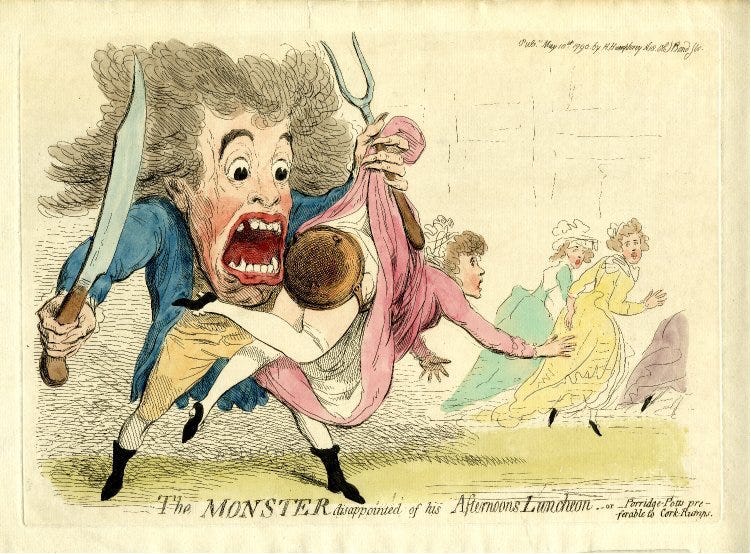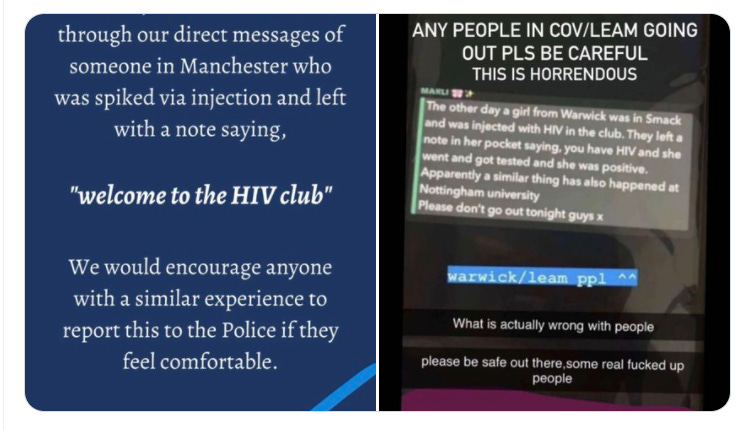Injection Spiking and the history of needle scares
Is Injection spiking a thing? How did it get to Astroworld?
This week’s Hat Tip looks at injection spiking.
When Houston police chief Troy Finner told the media that a security guard at Astroworld had been injected with an unknown substance, I wasn’t surprised. The story he told didn’t make sense, but that didn’t matter. It was only a matter of time before this particular panic spread from the UK and Ireland to the United States.

Nine people died in the crowd at Astroworld, trampled and crushed. The idea of an attacker with a syringe injecting drugs in bystanders just added to the sense of chaos.
Injection spiking
Since mid-October, the British press has been filled with reports of what’s become known as ‘injection spiking’.
Sussex police alone is investigating 31 reports of injection spiking; nationally, police forces must have had hundreds if not thousands of reports. The typical injection spiking story goes something like this:
Someone (usually, but not always, a woman) is out at a bar or club. She begins to feel strange, woozy, dizzy. She leaves, or is helped home by a friend. The next morning, she notices a small mark on her arm or back that looks like a puncture. She realises she was injected with a drug in an attempt to ‘spike’ her akin to drink-spiking.
Sometimes the victim feels a sharp pricking pain before the dizziness or sleepiness comes on; sometimes s/he finds the puncture mark that evening and goes straight to hospital.
What these incidents don’t feature, on the whole, is anyone seeking to exploit the vulnerable state of the victim. Injection spiking cases mostly don’t appear to be preludes to sexual assault; the spikings themselves are the assault. But that doesn’t make them any less scary.
Some history
When I was a teenager in the late 1990s, I heard a story about a man who went around clubs with needles filled with his own HIV-Positive blood. The man would dance with his victim and then hand her a card. As the victim took the card from the man, she’d feel a sharp pain in her arm, but by then he was gone. She’d been stabbed by his needle. The card he gave her read “Welcome to the HIV club”.
This story never happened, but it was a very common urban myth in the 90s, along with other variants. Sometimes the injector slipped a note in his victim’s pocket to be found later. Sometimes the HIV needles were planted in cinema seats; sometimes in payphones or vending machines.
This was just a new form of an older urban myth. In New Orleans in the 1920s-30s, ‘Needle Men’ from Charity Hospital were rumoured to inject black residents with poison in the street in order to use their bodies to medical students for dissection; Game of Thrones author George RR Martin wrote a short story in 1981 about Needle Men. In another version, the Needle Men were said to be drugging young women to kidnap them and sell them into forced sex work.
Further back, the London Monster terrorised London in the late 1780s, stabbing or pricking women in the buttocks, or slashing their dresses from behind, and running off. So strong was the panic that some women wore copper bottoms under their clothes to protect themselves. A Welshman, Rhynwick Williams, was eventually convicted of being the Monster, though he was released after public outcry because he had alibis for some of the other attacks.
Historians today are divided on whether the Monster was one man, or multiple copycats, or maybe never existed at all. At the least, perhaps the less-severe pricking attacks ascribed to the Monster were an example of mass hysteria.
The Drink-Spiking Scare
Injection spiking is a newer, scarier variant of drink spiking. Anyone under the age of 45 was probably taught in college to never accept a drink from a stranger in a bar unless you saw it prepared because it could contain a sedative or inhibition-reducing drug like GHB or a benzodiazepine like Rohypnol. There are drink test kits, covers for glasses and an array of other anti-spiking tools.
But the evidence suggests that this sort of spiking is much rarer than believed. A UK study looked at 1014 reports of drug-facilitated sexual assault between the years 2000-2002 and found that in only 2% of cases detected this sort of spiking.
In 21 cases (2%), a sedative or disinhibiting drug was detected which had not been admitted and could therefore be an instance of deliberate spiking. This included three cases in which complainants were allegedly given Ecstasy (MDMA) without their knowledge. Other drugs detected included gammahydroxybutyrate (GHB) and the benzodiazepine drugs diazepam and temazepam.
To be clear: these 1014 people (mostly women) were really sexually assaulted, but tests revealed that they weren’t spiked. That doesn’t take anything away from the real assaults that happened. But it’s important for understanding the risks.
People sometimes feel faint, tired, dizzy and strange, especially in hot, stuffy nightclubs after a few drinks. People are bad at judging how much alcohol they’ve consumed.
And, of course, drink spiking with alcohol is extremely common. When I was at university, if you bought a girl a vodka and coke, it was considered perfectly acceptable — even polite! — to get her a double instead. But actually, that’s spiking a drink. It’s giving someone more of an intoxicating, inhibition-lowering, judgement-impairing drug than they asked for or were expecting.
Drink spiking with sedatives happens. And maybe it happens more now than in 2002. But it doesn’t happen anywhere near the level that people think.
The Injection Spiking Scare
So are hundreds of people being spiked by injection? Probably not.
For one thing, it’s not clear what drug fits the profile of the cases as described.
It would need to be something that can be injected anywhere: backs, necks, and hands are common sites mentioned by victims, but those aren’t good sites for either intramuscular or subcutaneous injection.
It would need to be something that works at a very low dose, because victims report either feeling a pinprick or nothing at all. If it would take a few seconds to inject, that’s too long.
It would need to be undetectable in blood or urine tests just a few hours later. Many victims went to the hospital the next morning, and some went straight from the club.
There are no obvious candidate drugs that fit. Add to that the sheer scale of the claims, the fact that victims are mostly not being assaulted or pursued… it doesn’t add up. So far, there has been no publicly-confirmed positive test that detected a drug in an injection-spiking victim’s system.
In VICE, Sophia Smith Galer spoke to medical professionals who expressed a lot of scepticism that people were being drugged via injection. Louise Perry in the New Statesman shared similar concerns.
And some of the early injection spiking claims were… oddly familiar. As James Morsh tweeted on 20 October, stories were circulating about girls being stuck with needles and a message saying, yup, “Welcome to the HIV Club”.
Puncture marks
Of course, people aren’t lying about this. They really did feel strange, really did go home, really did find something that looked like a puncture mark.
I’m not going to post the pictures that people have shared here, because it feels like an intrusion, but I will say that one widely-shared picture looked exactly like a mosquito bite, including the raised skin. One looked like a small scratch. One looked like a little spot.
Today while in the supermarket I noticed, suddenly, a little cut on my wrist. I don’t know where it came from. But I wonder if I might have mistaken it for a puncture mark if I was already scared of injection spikers?
Arrests
What about the arrests? Five men have been arrested on suspicion of injection spiking — two in Nottinghamshire and three in Brighton.
I spoke to the police forces who didn’t want to give any information, but if any of the arrested people had been actually charged with a crime, it would have been made public. It’s been three weeks since the Nottinghamshire arrests so charges probably aren’t going to happen.
Spreading to America
In just a few weeks, injection spiking reports swept the UK and Ireland, and it’s no surprise to see them beginning to pop up across the Atlantic. A tragedy like Astroworld attracted masses of conspiracy theories, from claims about satanic rituals to antivax nonsense, making the injection spiking claim seem almost tame by comparison.
The Houston police chief’s claim led to Attorney-General Merrick Garland being asked if the Federal government was investigation injection spiking, raising its profile further.
A few days later, the truth came out.

There was no such incident. A security guard was punched, not injected.
But it’s probably too late now. Expect to see injection spiking reports coming to a community near you.






